Link building is manual promotion.
Securing real, worthwhile links means promoting a page on your site to a relevant audience. But, link building isn’t magic; the promotion will only be successful if the asset is link-worthy.
There has to be real value for the site linking, and their audience.
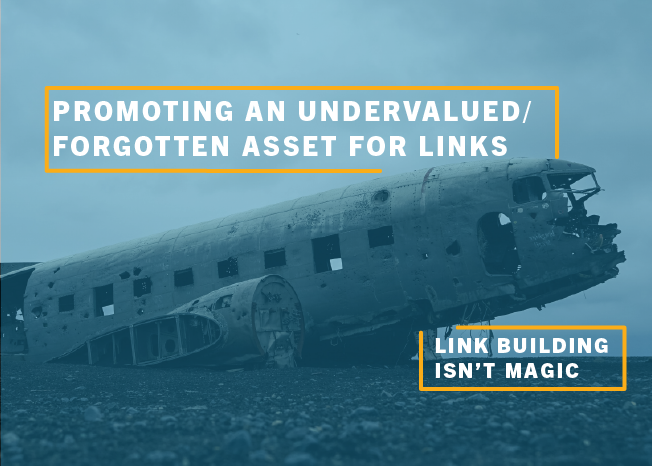
Link building exists to close the gap between the links you have and the links you deserve. The process works best when you have an asset that is link-worthy, but hasn’t received the appropriate attention and recognition.
This is not an uncommon situation. Companies often invest into asset creation, but fail to strategically promote - leaving value (and links) on the table.
Link builders are adept at capitalizing on these opportunities, by finding relevant audiences for your asset/site and securing the links you deserve. This helps your page perform better in search, building consistent traffic and breathing new life into your deserving asset.
Identifying forgotten and undervalued pages can provide a hidden source for link acquisition and further marketing.
Finding and Promoting Under-performing Assets
In this post I will highlight the full process of identifying under-performing assets, finding promotional opportunities, and contacting site owners to secure links. The basic process is as follows:
- Find under-promoted assets.
- Manual research – sifting through content on site.
- Content analysis tool – check the performance of your content with a tool.
- Backlink explorer – see which pages on your site have already accumulated some links (or are suitably lacking).
- Search for link opportunities.
- Find prospects within content analysis tool.
- Search Google for potential opportunities.
- Contact site owners to secure links.
- Find appropriate contact information.
- Email site owner requesting link.
- Concise
- Clear
- USP
- Value-driven
In order to find and promote linkable assets, you must understand exactly what constitutes a linkable resource.
What is a Linkable Asset?
A linkable asset can come in many forms:
- Blog post
- Infographic
- Video
- Interview
- Research data
- Quiz
- Industry survey
- Podcast
- Etc.
The key ingredient is unique value.
An asset that is link-worthy provides some type of value (education, entertainment, news, etc.) to a specific audience, which is why other sites are willing to link. Because of the inherent value a linkable asset has, other site owners want to share that value with their readers/audience via linking.
Often this is content sites would link to (without any persuasion) if they only knew it existed.
Persuasive outreach can only go so far. The key is to start with something worthy of links, and then make your intended audience aware it exists.
For more information on linkable assets, check out these resources:
- 9 Tangible Linkable Asset Ideas and How to Build Links to Them by Jason Acidre
- Creating and Promoting Linkable Assets, the Ultimate Guide by Pratik Dholakiya
- Link Building Expert Panel Discussion: Leveraging Linkable Assets and More (Panel Webinar)
Linkable assets are different from other types of content because they are inherently link-worthy, which is different from share-worthy.
Social Sharing Vs. Linking
Many pieces of content receive numerous social shares but little to no links simply because social sharing is easier. Also, some content is simply better-suited, and designed for social sharing rather than linking.
Clicking a Twitter button, retweeting, or even composing an original tweet, is much easier than creating a hyperlink. Creating a social account is certainly much less effort than creating and maintaining a relevant (and useful) website.
Consider the difference:
In order to link, first you need to have a site to link from. Secondly, you need to be actively maintaining that site. Third, you need to be inspired enough to update that site on the spot, or remember that resource later when you’re updating your site. That likely requires finding the asset again.
That’s a lot of needs. Definitely not a simple process, which is why links require strategic, manual promotion.
Because there are fewer barriers to social, obtaining shares is much easier than acquiring links. Because securing links is more difficult than obtaining social shares, finding link-worthy assets can be difficult.
Fortunately, there is a process you can follow for finding and promoting undervalued resources.
Part One: Finding Under-Promoted Assets
While linkable assets may already exist on your site, they may not be obvious. It will take some digging and analysis to identify the opportune assets.
For this post I will use an example from Fossil to demonstrate an entire campaign: from the first step of identifying the asset, all the way through to finding link opportunities and outreach.
Step One: Manual Research
The first step in finding a linkable asset is manually reviewing the website in question.
Skipping right to tools is a mistake; you should start by familiarizing yourself with the site.
Since I’m looking for a linkable asset I’m going to start my search in the most logical place for an asset to live - Fossil’s blog.
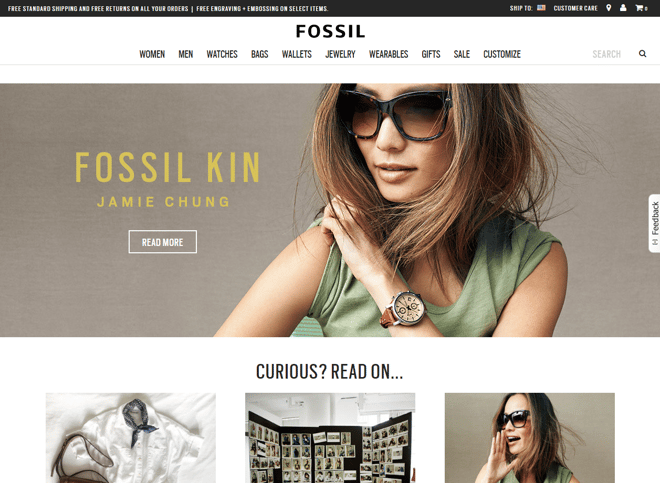
Immediately I notice a technical issue that might be impeding Fossil’s ability to rank (irrespective of links). The blog is buried under a few subfolders-- https://www.fossil.com/us/en/blog.html--which isn’t optimal.
Also, from a content marketing perspective Fossil should name their blog something unique, rather than just “The Blog”.
Technical issues should be resolved before you launch your link campaign. Link building campaigns are handicapped when technical SEO isn’t optimal.
On the surface, Fossil’s blog is visually appealing. But after manual examination, nothing jumps out.
Most of the content is quite short with a few pictures.
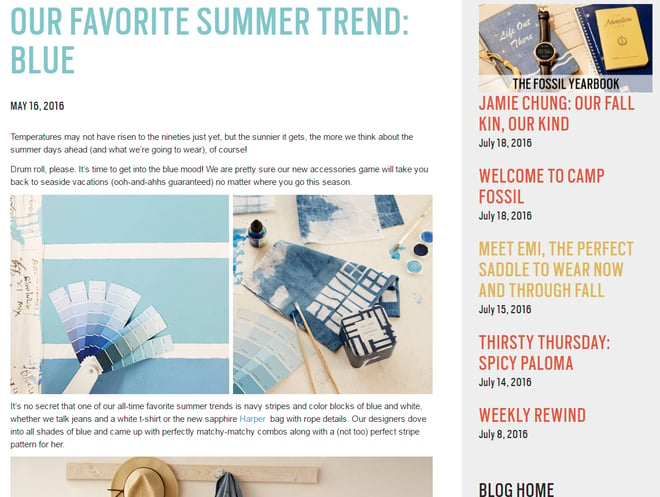
Visually pleasing, and if those are proprietary images I might have a chance for image link building. That’s a different post, though.
The blog is decent, but I don’t see anything that seems particularly link-worthy. Many of the posts simply highlight Fossil’s products and don’t really offer any value beyond that.
In fact, content promotion may not be the most lucrative strategy for Fossil, because they don’t appear to have many resource-driven assets. I would definitely recommend exploring other link building tactics in conjunction with resource links if I was developing a link acquisition strategy for Fossil.
I’m going to have to dig deeper to see if I can find something that’s proven popular and might attract links.
Step Two: BuzzSumo (Content Analysis Tool)
One option for finding link-worthy pages is BuzzSumo. BuzzSumo reports social share metrics on your site’s individual pages, which helps determine the popularity of a page.
To find the top-shared pages on Fossil, I simply enter their domain into BuzzSumo.
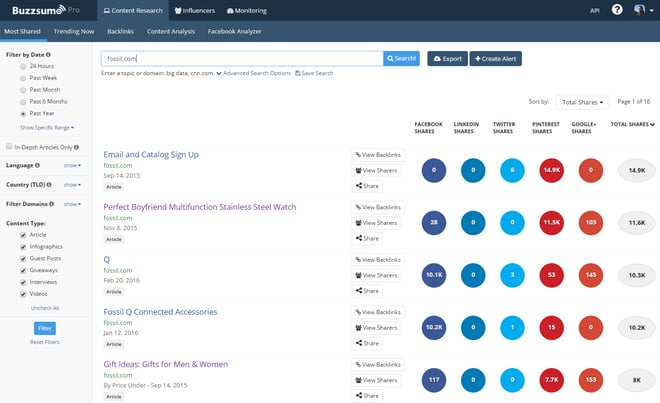
BuzzSumo reports which pages on Fossil were shared the most on social media.
At first glance I can see many of these top-shared pages are product pages:
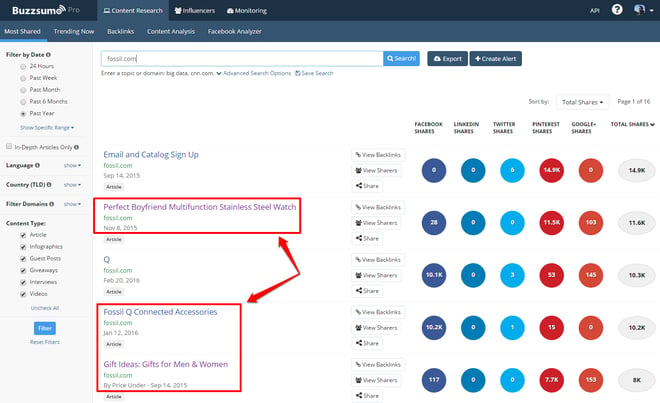
These pages might be shared frequently, but won’t translate well to linkable assets. Sites are often reluctant to link to product pages.
I’ll have to sift through the product pages in order to find resources or blog posts that sites will be more likely to link to.
On the third page of BuzzSumo I find a potential asset (and the example we’ll use) - a blog post titled “How to Wear It: Seaglass Jewelry” that has 197 Pinterest shares:
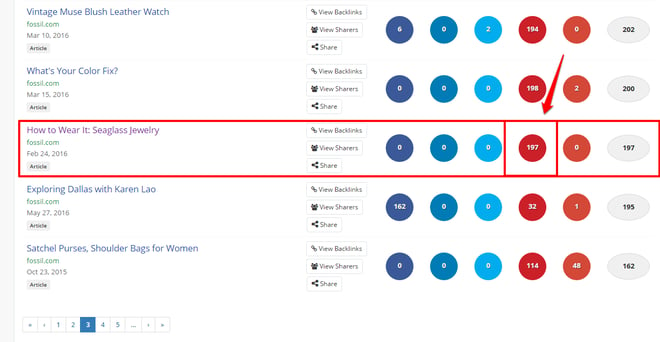
The fact this post has a fair number of Pinterest shares indicates it could be a potential asset.
Although I skipped past a number of results with more social shares, those pages were product pages that didn’t offer unique value outside of shopping. However, the “sea glass” page offers substance beyond just a product.
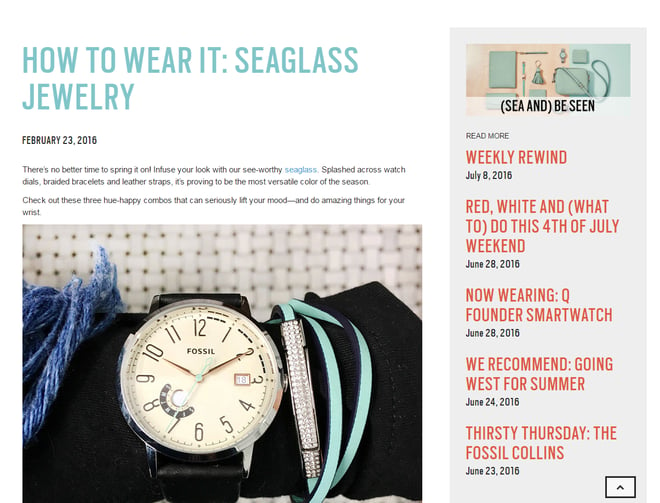
There’s a strong chance the page will serve value to an audience, beyond offering a product to purchase.
Social popularity can translate to link popularity. Beyond that I can see that the post actually offers fashion advice and ideas. The uniqueness of sea glass as a color/style also adds potential for link-worthiness. The page has a unique value (USP), allowing us to position it well in our promotion for links.
Note: Always manually check anything you find with a tool. BuzzSumo is great for finding potential assets, but you should rely on your own expertise to confirm an asset is worthy of links.
The fact that 197 people “pinned” this post on Pinterest shows it might earn links with the right promotion. Since my goal is links, before I begin a promotional campaign I’m first going to check how many backlinks the page has to determine whether it’s truly under-promoted.
Step Three: Majestic (Backlink Explorer)
One of the best options for analyzing link data is Majestic. I simply enter the URL into Majestic and it will report how many unique domains are linking to the page.
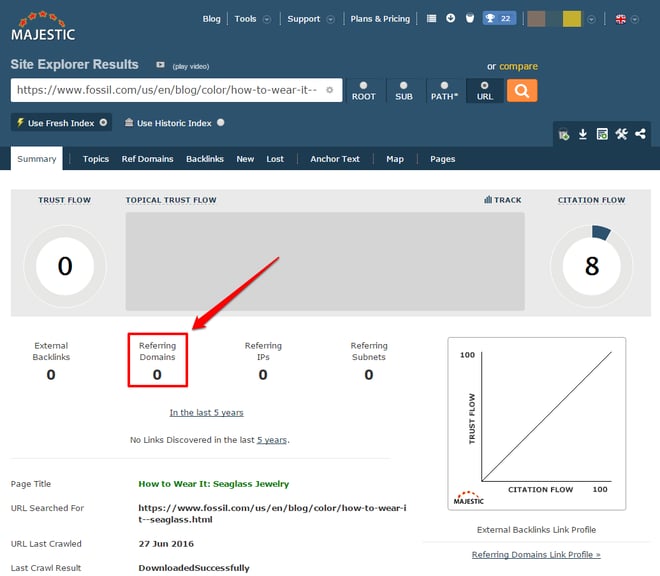
Zero. It’s obvious this page hasn’t been promoted.
Now that I have an asset that shows promise, I can begin searching for potential opportunities.
Part Two: Search for Link Opportunities (Link Prospecting)
With an asset in hand, it’s time to find link opportunities.
Locating link opportunities is the process of identifying relevance and the value (USP) of your content to different audiences.
Step One: BuzzSumo
BuzzSumo is handy as as a launching point in the discovery process, because it sparks imagination and creativity. BuzzSumo will help you find similar content that has already proven popular with relevant audiences.
Since sea glass is the primary focus of the content I’m promoting, I’ll use BuzzSumo to see what content is popular with that topic.
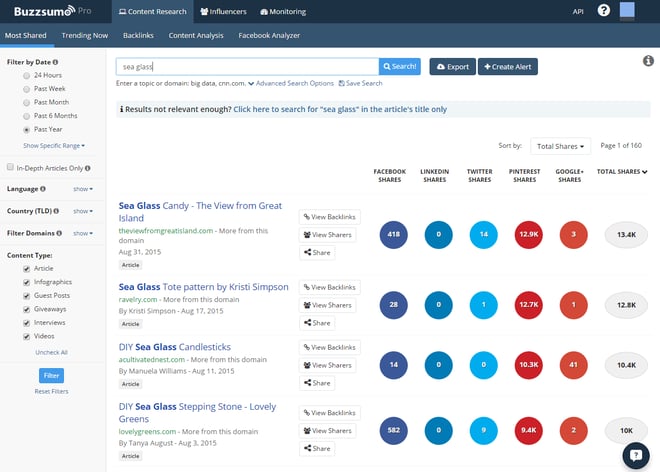
Digging through the various results, I see something that piques my interest:
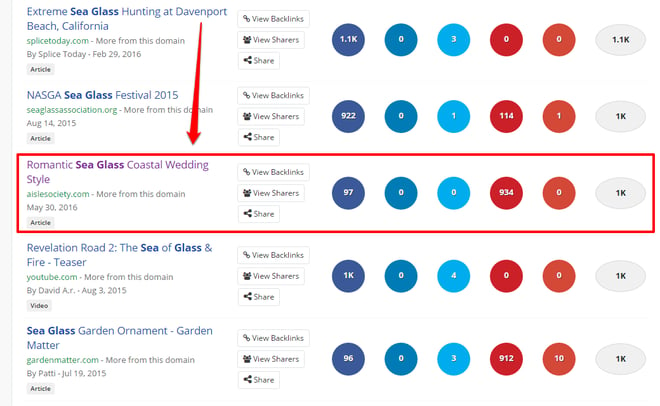
This result catches my eye because of the word “wedding”. Opening the page I can see that sea glass is a common color in beach-themed weddings.
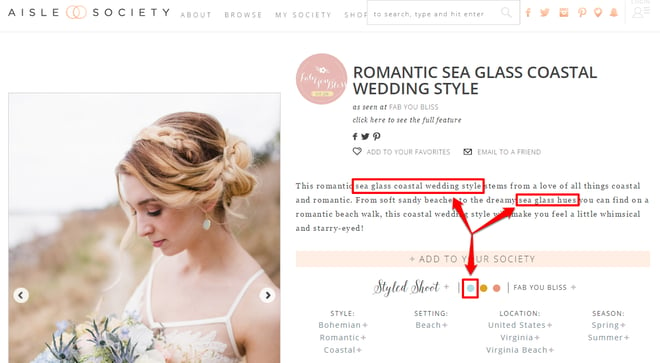
Perfect! I know from personal experience the wedding niche is a link-friendly community. Wedding sites typically link freely and openly, as long as you have a resource worthy of a link.
To promote Fossil’s page about sea glass, I’ll search for sites that either have sections, categories, or individual posts covering beach-themed weddings—which will make sea glass an appropriate fit. The accent jewelry mentioned in Fossil’s post would be relevant to any bride who wants sea glass accents to their wardrobe.
Time to use our best link prospecting tool: Google.
Step Two: Google Search
A simple Google search for “sea glass wedding” returns a potential link prospect on page one:
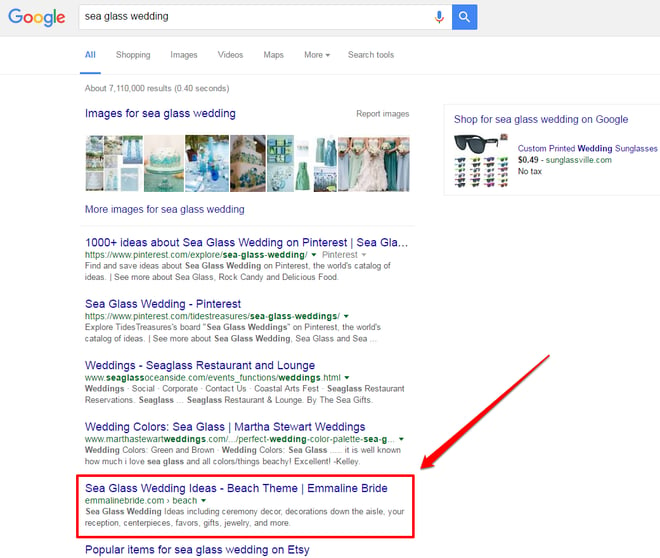
Clicking into the page takes me to a post that outlines a number of different sea glass themed wedding ideas.
Scrolling down the page takes me to a section that discusses various jewelry options:
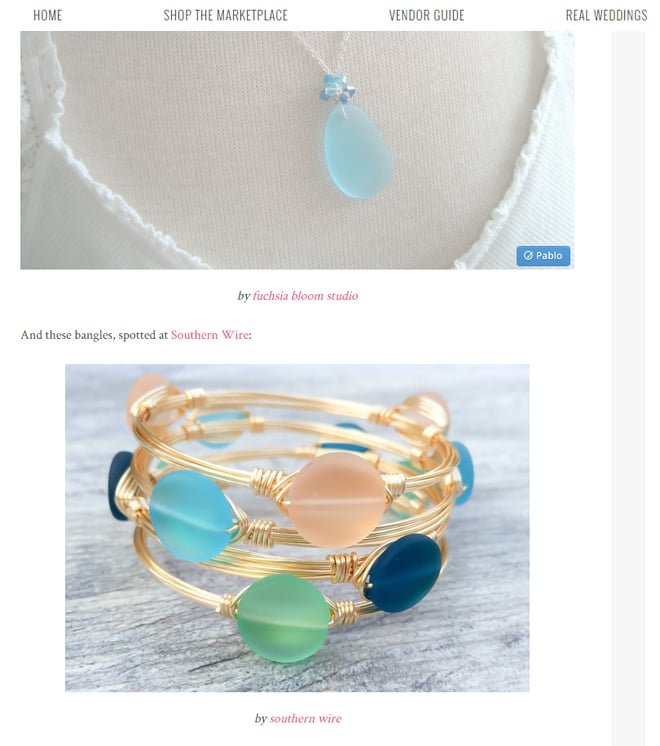
Along with the images, there are citation links:
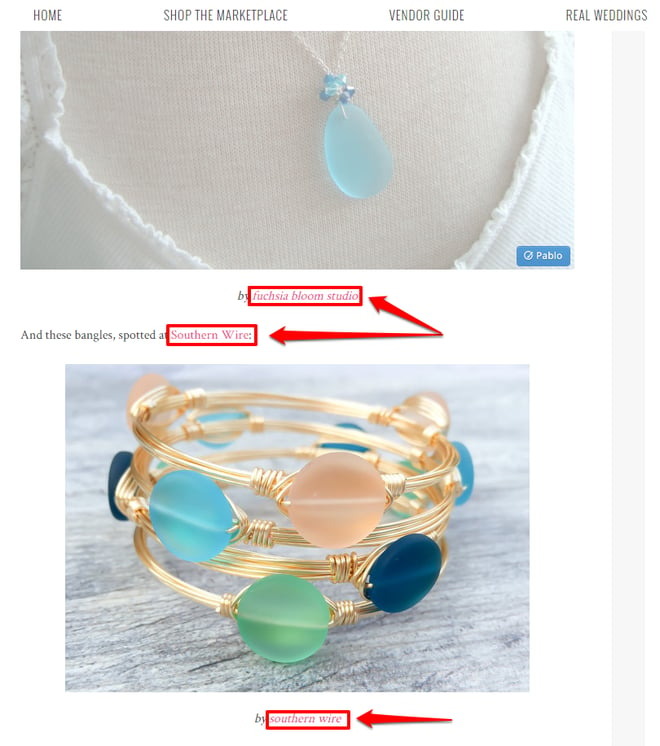
This is a solid link opportunity for Fossil’s post. I could email the site owner and suggest the addition of Fossil’s accessories (with images and links) as it would add value to the post – offering another sea glass inspired wedding idea.
In fact, if the author of the post didn’t think the accessories were a good addition, another option would be to add the watches (also featured in Fossil’s post) as a potential anniversary gift idea down the road (watches are the modern gift theme for a couple’s fifteenth anniversary).
Now that I’ve identified a potential link prospect, it’s time for outreach.
Part Three: One-to-one Outreach
The final step in the content promotion process is outreach.
Human-to-human communication is the core of manual link building, and a fundamental pillar in all marketing. If you want people to be aware and excited about your product, service, or content you need to promote it to them. This is what makes these assets underutilized – the fact that they weren’t given the promotion they deserve.
The outreach process starts with finding the appropriate contact information. By scrolling to the bottom of the page I can see a link to a “Contact” page:
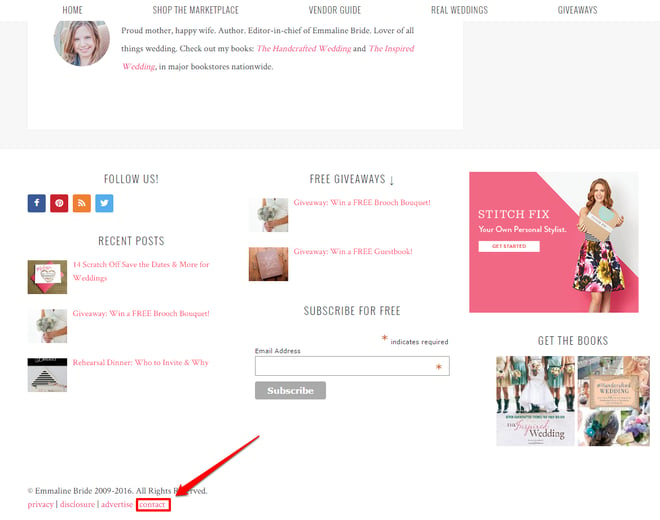
Clicking the link takes me to a contact page where an email is listed:
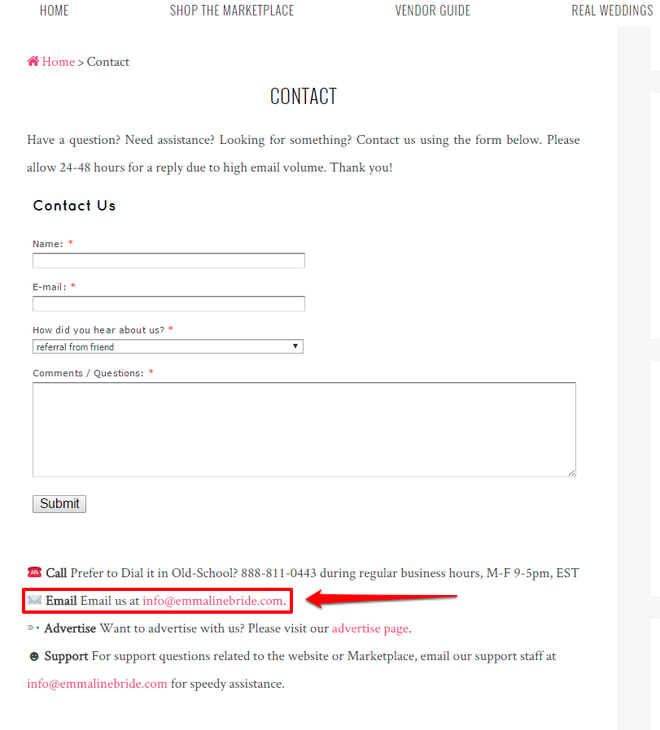
Although this is a generic email (rather than a personal account) it’s still more personal and human than using the contact form, so I’ll send my outreach message to this address.
If I wanted to dig deeper I could use a tool like Findthat to find a more specific email.
My proposed outreach would look something like this:
Hello Emma,
I found your post “25 Beachy Sea Glass Wedding Ideas” and really enjoyed the creative, inspirational ideas. I’ve always felt the smaller, more intricate details really bring a wedding together.
I wanted to suggest adding one more idea to the post. These sea glass wraps and bracelets from Fossil would be a perfect accessory to accent the sea glass jewelry (earrings, necklace, or bangle) you referenced. (In fact, the sea glass watches would make for a perfect beach-themed 15th anniversary gift. But maybe that’s for another post!)
I’d be happy to send over the high-resolution images from the post so you could embed them in the article.
I believe the addition will be useful to your audience and any beachy bride/grooms-to-be.
Thanks again for sharing all the wonderful sea glass ideas, and I look forward to hearing from you!
Cheers,
Andrew
This may not be the single greatest outreach email ever sent, but it does include all the important elements of an effective outreach message:
- Demonstration of value – Fossil’s wraps and bracelets accent other sea glass themes and jewelry.
- Clear CTA – Add images and links of Fossil’s wraps and bracelets.
- Secondary CTA – Look forward to hearing from her, implying I expect a response.
Even if this outreach is unsuccessful in securing a link, I’ve contacted Emma and created a connection which can lead to other marketing opportunities. Relationship building is integral to effective link building--and all marketing--making human-focused outreach essential.
More Link Opportunities
I’ve provided a step-by-step, detailed process of how I would pursue this individual opportunity. However, in a link campaign your goal is to secure more than just one link. Using my same example (Fossil.com) I can find many more link opportunities.
Examining the rest of the Google search results for “sea glass wedding” uncovers more potential opportunities:
- http://www.marthastewartweddings.com/228745/perfect-wedding-color-palette-sea-glass#145287
- http://www.marryyoume.com/2009/07/inspiration-board-sea-glass-wedding.html
- http://www.dressforthewedding.com/seaglass-bridesmaid-dress/
- http://flyawaybride.com/sea-glass-blush-wedding-colour-palette/2013-01-29_0006/
- http://www.lovestruckweddings.co.uk/wedding-inspiration-seaglass/
I also found opportunities within the search results for the query “beach themed wedding”:
- http://bridalguide.com/planning/the-details/reception/beach-wedding-ideas#139259
- http://www.womangettingmarried.com/21-fun-easy-beach-wedding-ideas/
- https://www.buzzfeed.com/mallorymcinnis/mermaid-to-be-together?utm_term=.kxyeLrEQR#.lbKJYwq4z
- http://bodasyweddings.com/how-to-plan-a-beach-themed-wedding-ceremony/
- http://www.brit.co/nautical-wedding/
- http://ideastand.com/cool-beach-wedding-ideas/
- http://www.weddingideasmag.com/how-to-create-a-totally-tropical-beach-wedding-theme/
- http://blog.wedpics.com/21-beach-wedding-ideas/
- http://www.hitched.co.uk/wedding-planning/organising-and-planning/beach-wedding-ideas_895.htm
Another option for finding viable opportunities is to examine the backlink profiles of the content ranking for relevant queries. For example, I scrutinized the backlinks of the top performing content for the search “beach wedding accessories” and found these opportunities:
- http://www.maweddingguide.com/planning/costs/high-end-for-less.htm
- https://www.elegantweddinginvites.com/35-gorgeous-beach-themed-wedding-ideas-s/
- http://www.canvasfactory.com/blog/beautiful-beach-weddings-celebrate-sun-sea-surf/
- https://www.invitationsbydawn.com/blog/2011/01/accessorize-your-destination-wedding-theme-70.html
- http://www.sweetmemorybaskets.com/wedding-planning/super-easy-tips-how-to-minimize-wedding-cost-for-your-bridal-party
- http://beachwedding.tips/2014/05/19/beach-wedding-color-theme-let-sea-inspire-choice/
- http://www.weddingomania.com/20-colorful-and-bright-beach-wedding-inspirational-ideas/
- http://www.knotsvilla.com/beach-wedding-inspiration-10-ways-rock-beach-wedding/
- http://www.beachwedding-guide.com/beachweddingaccessories.html
These are quick and dirty examples that I’ve grabbed from cursory research. All of these sites would bear further scrutiny and analysis--and I would likely not pursue every prospect—but these examples show there is plenty of opportunity to secure worthwhile links.
And there you have it—the foundation of a link campaign.
If I were to build links for Fossil, this would be the content promotion aspect of the overarching strategy to secure links.
Recap
Linkable assets are crucial to securing relevant, worthwhile links. However, you don’t necessarily need to create new content if there are hidden gems already living on your site. Finding and promoting these forgotten assets can help you secure the links you deserve.
To recap, here are the steps I outlined in my Fossil example:
- Find under promoted assets.
- Manual examination of the site.
- BuzzSumo to identify popular content with potential for links.
- Check backlinks pointing to asset using Majestic.
- Search for potential link opportunities.
- BuzzSumo to check popular content related to your asset and generate potential linking ideas.
- Search on Google to find potential link prospects.
- One-to-one outreach.
- Find most appropriate contact information.
- Craft outreach email/message.
- Secure link and/or build a positive relationship.

